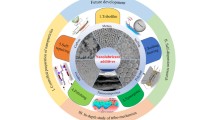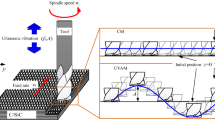The obtained results of investigations confirm the possibility of formation of solid lubricant coatings (SLC) by using MoS2 dry powders subjected to the wave vibration impact treatment in a medium of steel beads, which trigger the deformation of the surface layer in the presence of MoS2, and the formation of the corresponding coating. Based on the analysis of the results of investigation of the characteristics of vibration treatment in the medium of metallic bodies, we propose a model of the formation of MoS2 SLC as a result of vibration treatment. The application of SLC in vibration treatment gives a lower friction coefficient and the elevated wear resistance. A physical and mathematical model is proposed for quantitative assessment of the adhesive strength of SLC MoS2.





Similar content being viewed by others
References
H. E. Sliney, “Solid Lubricants,” in: ASM Handbook, Vol. 18: Friction, Lubrication and Wear Technology, 10th Ed., ASM Int., Ohio (1992), pp. 113–122.
A. P. Babichev, P. D. Motrenko, V. V. Ivanov, S. N. Khudoley, and Y. P. Ankudimov, Mechanochemistry of Finishing and Strengthening Treatment in Vibration Treatment and Coating of Machine, Don State Technical University DSTU, Part-Publishing Center, Rostov-on-Don (2012).
K. Hamouda, H. Bournine, M. A. Tamarkin, A. P. Babichev, D. Saidi, and H. E. Amrou, “Effect of the velocity of rotation in the process of vibration grinding on the surface state,” Fiz.-Khim. Mekh. Mater., 52, No. 2, 67–71 (2016); English translation : Mater. Sci., 52, No. 2, 216–221 (2016).
E. W. Roberts, “Ultralow friction films of MoS2 for space applications,” Thin Solid Films, 181, No. 1–2, 461–473 (1989).
A. I. Brudnyi and A. F. Karmadonov, “Structure of molybdenum disulphide lubricant film,” Wear, 33, No. 2, 243–249 (1975).
J. M. Cunningham, I. J. Ford, J. A. Ogilvy, and E. W. Roberts, “Interpretation of friction and wear properties of MoS2 coated steel substrates,” Wear, 177, No. 1, 93–101 (1994).
K. A Ravindran and P. Ramasamy, “Frictional behaviour of phenolic-bonded molybdenum disulphide films in spherical contact,” Wear, 93, No. 3, 291–297 (1984).
A. Yabuki, M. R. Baghbanan, and J. K. Spelt, “Contact forces and mechanisms in a vibratory finisher,” Wear, 252, No. 7–8, 635–643 (2002).
A. Djema, K. Hamouda, A. P. Babichev, D. Saidi, and D. Halimi, “The impact of mechanical vibration on the hardening of metallic surface,” Adv. Mat. Research, 626, 90–94 (2013).
Author information
Authors and Affiliations
Corresponding author
Additional information
Published in Fizyko-Khimichna Mekhanika Materialiv, Vol. 53, No. 5, pp. 142–150, September–October, 2017.
Rights and permissions
About this article
Cite this article
Bouti, S., Аntonova, M.N., Hamouda, K. et al. Structure and Mechanochemical Properties of the MoS2 Solid Lubricant Using Vibration Wave Treatment. Mater Sci 53, 739–749 (2018). https://doi.org/10.1007/s11003-018-0131-1
Received:
Published:
Issue Date:
DOI: https://doi.org/10.1007/s11003-018-0131-1




